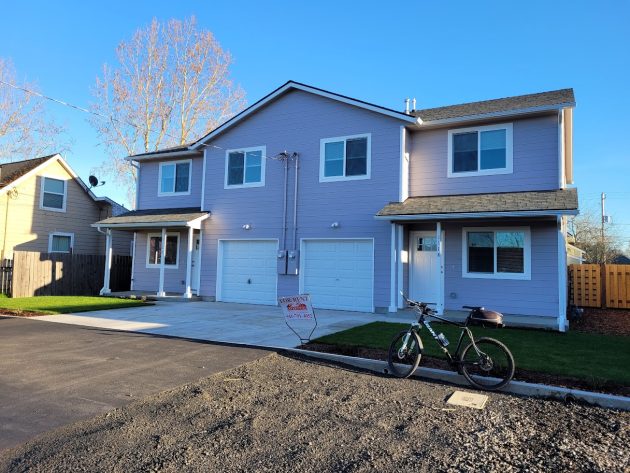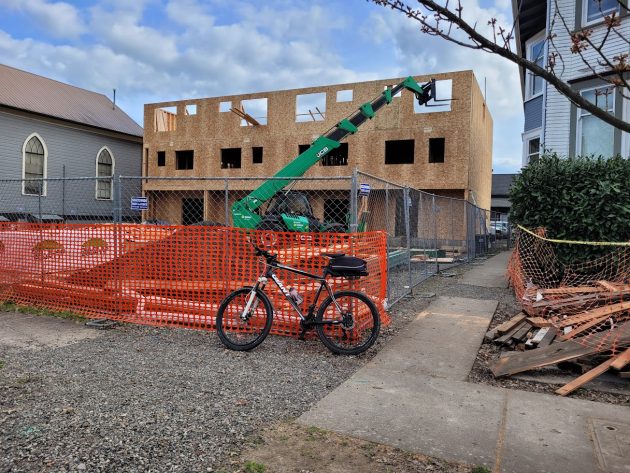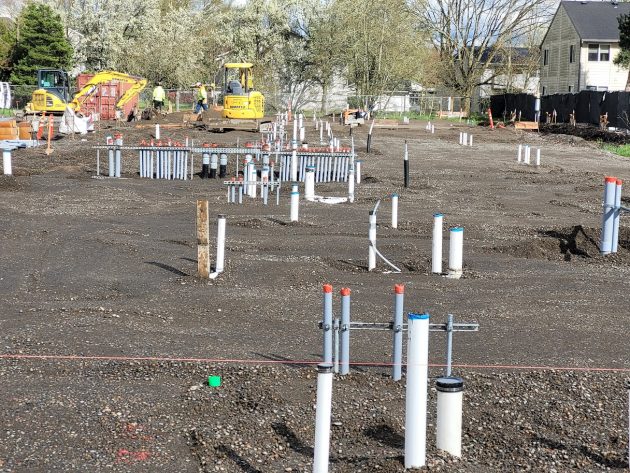
I went past this recently completed duplex at 1118-1122 Sixth Ave. S.E. on March 18, when the sign said the units were still for rent.
Criss-crossing Albany on a bike, I often stop and look at construction sites, especially those where new housing has just been finished or is still being built.
The photos here show three examples of different housing types, all of them using “infill” sites within the developed part of the city.
Unlike other municipalities and Linn County, the City of Albany doesn’t report monthly statistics on building activity. So it’s hard to gauge whether construction is up or down.
But just looking around, it’s hard not to notice new houses, apartments or “middle housing” like duplexes going up.
And more housing is being planned. Since the first of March, five land use applications involving more housing have been filed with the city’s planning division.
The biggest of the five applications proposes a 113-lot subdivision off Ellingson Road at the south end of town, where two or three developments of similar size have already been built or approved
The other requests: A nine-lot subdivision to build townhouses at N.W. Gibson Hill Road and Sunny Lane; a two-lot division at 2240 Water Avenue N.E.; a “middle housing” land division for four townhouses at 1955 Water Ave. N.E., and a site plan and tree-felling permit for what looks like eight units at 2336 Jackson St. S.E.
If you look at the ads showing up online, the asking price of housing makes you dizzy. Whether building more will ever have an effect on prices, I don’t know.
But as long as people want to move to Albany — and many apparently do, judging by the the city’s steady population growth — it’s clear there will be a market for places for people to live. (hh)

Eight three-story townhomes were under construction here, at 220 Third Ave. S.E., on March 21.

The Creekside Meadows apartments, with 107 units in three three-story buildings, are being built at 1755 Geary St. S.E. I took the photo on March 26.

What is Albany using the money they receive from building permits on? Certainly not the roads or the schools. I have said it before and I’ll say it again, Albany schools will not be able to handle the increase of students that these new developments will create. The school system is already in pretty dire straits.
It’s the “new” housing being built that’s driving prices upwards – the price of materials, labor, and fees are ever increasing. This in turn drives the current prices for home buyers and renters up as well. The current catch phrase of “affordable housing” is a misnomer. And as home prices may fluctuate, rentals do not…once increased, they never drop down; thereby, either forcing people to the streets or worse yet, onto government assistance or government run housing. To use another catch word, this is not “sustainable”. Government (through your votes) created these problems…say they want to fix it…but, if you are paying attention…they never attain it.
Thank you for the update.
Hasso
I love your commentary’s and enjoy reading your updates on Albany. Along with this much needed growth which doesn’t appear to assist our out of control homeless population since they are allowed free land garbage and food from churches why would they work for a $2000+ rent that these new apartments charge. However, nothing is being said about the poorly laid road infrastructure and traffic. The city waits until the tax payers are so frustrated they will vote in a bond to fix instead of planning ahead before building. I thought we had a “Planning Department “?
It would be nice if we voted in some sensible council people who looked out for the citizens instead of their own special interests.
Great observations, I appreciate you sharing these local stories.
To the commenter about where the city diverts the permit monies, while a good question, as the costs are one of the major reasons housing is so expensive. As for the schools, they will benefit most from more housing as they are funded by property tax assessments, not permit fees. Our schools are more than adequately funded, and enrollment is down, that is a non-issue. The issue at hand is are we using development charges to expand infrastructure?
Building permit fees support the building and planning functions of city government, as I recall. Systems development charges, the largest component of what the city charges before one can build, are set aside for park, street and infrastructure projects made necessary by growth. As for schools, they are funded mainly by the state income tax. The property tax collected for school operations does support schools, but school district revenue is calculated based on the state budget and local enrollment.
Sorry TLH-ALB1 – but we need all types of housing NOW, supply is restricted by land use and government regulation, thus why prices keep increasing. Adding supply creates competitive pricing pressure down, not up. What drives up cost is limiting supply. Many who have purchased the affordable housing built 25 years ago, are now unable to sell as there is no more buildable land to upsize to, this means those in apartments who could have purchased a single family home, are stuck, and those sharing, or living in substandard housing, have no vacant apartments to move into because the ladder is clogged on many rungs. Urban growth boundaries, environmental restrictions, costly development charges, and other government obstacles have driven pricing up and supply down. We cannot have an open border and anti growth policy in the same country. They are the opposite of what we need to afford to live in America.
Our company did a job interview with a guy that was sent here from California to live at the helping hands shelter expecting the low barrier requirement. He said he received drug addiction treatment through other programs because drugs and alcohol are readily available at the shelter through others that consume it. He said the shelter was a very negative environment and all they did was use him for free labor. Other programs helped him get back on his feet. He also said that many of the homeless were like him and were sent here to live in Albany by other facilities from all over the US. They expect to live at the shelter and continue using drugs and alcohol due to the low barrier requirements. The people that are homeless due to circumstances beyond their control are forced to live with these people and no way out. They need a place to live. Do we want a city full of people who want to live in dysfunction or do we want to help the good people who have fallen on hard times? Offering a place to hang out and continue using is not helping anyone. Affordable housing would alleviate a huge portion of the homeless crisis. The good people in Albany need to encourage the city to help these people instead of creating more of them. A home for everyone should be the goal.